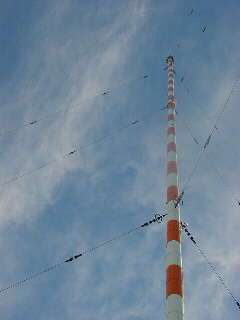Exercise 2.6: Free Space Attenuation
A shortwave transmitter operated according to the modulation method "DSB-AM with carrier" works with carrier frequency $f_{\rm T} = 20 \ \rm MHz$ and transmit power $P_{\rm S} = 100\ \rm kW$. It is designed for a low-frequency bandwidth of $B_{\rm NF} = 8 \ \rm kHz$.
For test operation, a mobile receiver is used, which operates with a synchronous demodulator. If this is located at distance $d$ from the transmitter, the attenuation function of the transmission channel can be approximated as follows:
- $$\frac{a_{\rm K}(d, f)}{\rm dB} = 34 + 20 \cdot {\rm lg }\hspace{0.2cm}\frac{d}{\rm km} + 20 \cdot {\rm lg }\hspace{0.2cm}\frac{f}{\rm MHz} \hspace{0.05cm}.$$
This equation describes so-called free space attenuation, which also depends on the (carrier) frequency.
It can be assumed that the entire DSB-AM spectrum is attenuated like the carrier frequency. This means that
- the slightly larger attenuation of the upper sideband (USB), and
- the slightly smaller attenuation of the lower sideband (LSB)
are compensated for by a corresponding pre-distortion at the transmitter.
Let the effective noise power density at the receiver be $N_0 = 10^{–14} \ \rm W/Hz.$
For the first two subtasks, it is assumed that the transmitter transmits only the carrier, which is equivalent to the modulation depth being $m = 0$.
Hints:
- This exercise belongs to the chapter Synchronous Demodulation.
- Particular reference is made to the page Sink SNR and the performance parameter.
Questions
Solution
- $$\frac{a_{\rm K}(d, f_{\rm T})}{\rm dB} = 34 + 20 \cdot {\rm lg }\hspace{0.1cm}\frac{d}{\rm km} + 20 \cdot {\rm lg }\hspace{0.1cm}\frac{f_{\rm T}}{\rm MHz}= 34 + 20 \cdot {\rm lg }\hspace{0.1cm}(10) + 20 \cdot {\rm lg }\hspace{0.1cm}(20)\approx 80\hspace{0.1cm}{\rm dB} \hspace{0.05cm}.$$
- This corresponds to a power reduction by a factor of $10^{8}$:
- $$P_{\rm E}= 10^{-8} \cdot P_{\rm S}= 10^{-8} \cdot 100\,{\rm kW}\hspace{0.15cm}\underline {= 1\, {\rm mW} \hspace{0.05cm}}.$$
(2) From $P_{\rm S} = 10^5 \ \rm W$, $P_{\rm E} = 10{^–4}\ \rm W$ follows a free space attenuation of $90 \ \rm dB$. From this, we further obtain:
- $$20 \cdot {\rm lg }\hspace{0.1cm}\frac{d}{\rm km} = ( 90-34 - 26)\hspace{0.1cm}{\rm dB}= 30\,{\rm dB}\hspace{0.3cm} \Rightarrow \hspace{0.3cm} d = 10^{1.5}\,{\rm km}\hspace{0.15cm}\underline { = 31.6\,{\rm km}\hspace{0.05cm}}.$$
(3) For DSB–AM without carrier, that is, for a modulation depth $m → ∞$, the following would hold:
- $$ \rho_{v } = \frac{\alpha_{\rm K}^2 \cdot P_{\rm S}}{{N_0} \cdot B_{\rm NF}} = \frac{ P_{\rm E}}{{N_0} \cdot B_{\rm NF}}= \frac{10^{-4}\,{\rm W}}{10^{-14}\,{\rm W/Hz}\cdot 8 \cdot 10^{3}\,{\rm Hz} } = 1.25 \cdot 10^6\hspace{0.3cm} \Rightarrow \hspace{0.3cm} 10 \cdot {\rm lg }\hspace{0.1cm}\rho_{v } \approx 61\,{\rm dB}\hspace{0.05cm}.$$
- With modulation depth $m = 0.5$ the sink SNR becomes smaller by a factor of $[1 +{2}/{m^2}]^{-1} = {1}/{9}$ . Thus, the signal-to-noise ratio at the sink is also smaller:
- $$ 10 \cdot {\rm lg }\hspace{0.1cm}\rho_{v } = 61\,{\rm dB}- 10 \cdot {\rm lg }\hspace{0.1cm}(9) \hspace{0.15cm}\underline {\approx 51.5\,{\rm dB}\hspace{0.05cm}}.$$
(4) According to the calculations in subtask (3), the following condition must be satisfied:
- $$ 10 \cdot {\rm lg }\hspace{0.1cm}\left({1 + {2}/{m^2}}\right) < 1\,{\rm dB}\hspace{0.3cm}\Rightarrow \hspace{0.3cm} 1 +{2}/{m^2} < 10^{0.1}=1.259 \hspace{0.3cm} \Rightarrow \hspace{0.3cm}{2}/{m^2} < 0.259 \hspace{0.3cm}\Rightarrow \hspace{0.3cm} m > \sqrt{8}\approx 2.83 \hspace{0.3cm}\Rightarrow \hspace{0.3cm} m_{\rm min} \hspace{0.15cm}\underline {= 2.83} \hspace{0.05cm}.$$
(5) Answers 1 and 3 are correct:
- When using a synchronous demodulator, the addition of the carrier makes no sense unless the former is useful for the required carrier recovery.
- Since the carrier cannot be used for demodulation, only a fraction of the transmit power is available for demodulation $($one third for $m = 1$, one ninth for $m = 0.5)$.
